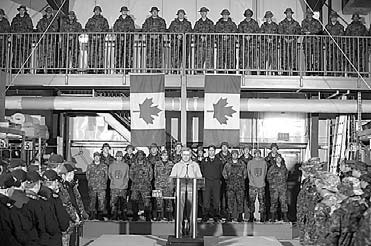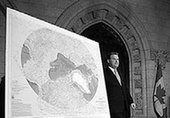Time line

1983
US President Ronald Reagan signs the United States Arctic Policy, which states that American interests in the Arctic relate to national security, natural resources, energy resources exploitation, scientific expeditions and environmentalism.
2003
The crew of a Danish frigate lands on Hans Island and replaces their national flag, which had been planted there since 1988.

August 2007
Russia symbolically stakes its claim to oil and gas reserves in the Arctic Ocean when two mini-submarines plant a Russian flag on the seabed of the North Pole.
May 2008
Foreign Ministers and other officials representing Canada, Denmark, Norway, Russia and the United States meet in Greenland at the Arctic Ocean Conference and announce the Ilulissat Declaration.
August 2009
Canadian Prime Minister Stephen Harper tours the country's three northern territories, demonstrating his government's view that territorial integrity in the Arctic area is one of its main missions.
May 2010
The Russian Ministry of Natural Resources and Environment announces that by 2039, Russia will be spending $346 billion to explore the continental shelf, and most of the funds will be used in Arctic exploration.

August 2010
Harper again tours the three northern territories, where he watches drilling in the Arctic region and makes a speech to soldiers.
2012
Denmark names its first permanent Arctic envoy and sets up the Joint Arctic Command in Nuuk, Greenland.
November 2013
The US Defense Department publishes its National Strategy for the Arctic Region, which is the US government's guideline for dealing with security in the region and its interests in the Arctic area.

December 2013
Canadian Foreign Affairs Minister John Baird says Canada will make a claim to the North Pole after a 10-year scientific research project on the extension of the continental shelf.
December 2013
The Russian Ministry of Emergency Situations announces that Russia built three Arctic rescue centers this year.
(China Daily 12/30/2013 page11)














